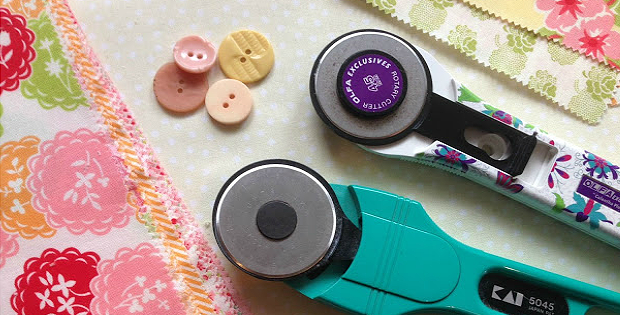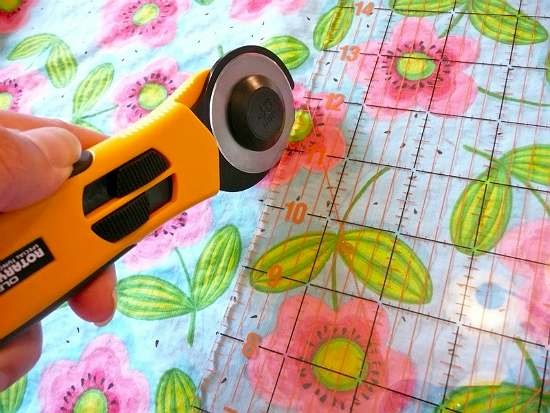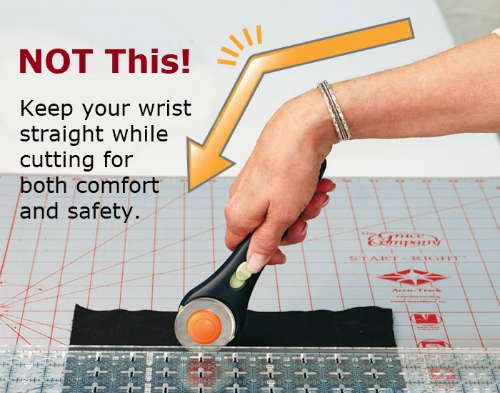How to Prolong the Lives of Your Rotary Cutters

With Care They’re Safer and Will Provide Years of Service!
Rotary cutters have become almost more important than scissors for quilters. In fact, it’s likely you can piece an entire quilt without touching the scissors, except for snipping threads.
It pays to take good care of your cutters so they give you good results for a long time. Fortunately, what’s best for the cutters tends to make them safer for you, too.
Photo from CraftCritique.
Here are some tips to prolong the useful life of your rotary cutters.
- A new cutter will seem a bit oily around the blade. Do not wipe that oil away. In fact, occasionally smear a tiny bit of sewing machine oil on the blade around where it’s screwed in to keep it turning easily.
- Always use a rotary cutting mat, as other mats will dull the blade more quickly.
- Hold the cutter so that you’re not bending your wrist. There should be a straight line from your elbow to the cutter blade. If your cutter isn’t comfortable for you to use in that position, look for an ergonomic model that works better for you (you’ll find several to choose from here). Or, you may need to raise or lower your cutting table. The correct position will allow pressure on the blade to be applied in a way that will extend its life, besides being safer for you.
- Butt the blade up against the ruler, and be careful not to nick the ruler as this will dull the blade. Avoid pins, as well.
- Always close the cover after every cut, and store the cutter with it closed.
- Wipe the blade clean, removing lint, dust and so on, after every few hours of use.
- Take your cutter apart and clean it regularly. This is also a good time to add a bit of oil.
- When replacing the blade, or after cleaning, make sure the screw is neither too loose nor too tight. The blade should turn freely without wobbling.
- If your blade is getting blunt and you don’t have a new one handy, try turning it backwards.
- Blunt blades can be used awhile longer in a second cutter that is designated for paper.
- Dispose of blunt blades by putting them in the case the new blade came out of. Tape it shut and put it in the trash.
Intocraft has an excellent article about rotary cutters and caring for them.
Photo from The Grace Company.
Never forget that rotary cutters are sharp and can cause serious injury.
- Stand while cutting so you can keep your arm straight without bending at the wrist. This gives you proper leverage, you can see better and it’s safer.
- Always use a thick ruler so the blade doesn’t slip and nick you.
- Never force the blade. If it’s cutting poorly or not turning properly, add a bit of oil, adjust the screw and/or replace the blade.
- Match the blade and cutter to the project. If you’re cutting small pieces, a large blade can be more dangerous. The reverse is also true.
- Always cut away from the body. While it’s tempting to fudge this a bit, especially on small piecing, a rotating cutting mat is much safer (find several to choose from here).
- Close the blade cover after every use and store it closed.
- Remove the blade, for cleaning or changing it, very very carefully.
- Sharp blades are safer than dull blades so change the blade often.
An article from All People Quilt provides additional insight into rotary cutter safety.
While it is possible to sharpen a rotary blade, be very careful should you choose to do so. Many quilters prefer buying new blades instead of running the risk of hurting themselves while sharpening them.
Click here for “Two Easy Methods for Sharpening a Rotary Cutter Blade”.
If you’re so inclined, you’ll find a variety of rotary cutter blade sharpeners here.
And if you’re ready for new blades the long-lasting titanium-coated blades found here get consistently good reviews.
Image Source: The photo at the top of the page is from Threadbare Creations. Read her tips for caring for rotary cutters here.













